There’s no sugarcoating it: shopping for a bass amp can be quite a headache. Whether you’re buying something small on a budget, or you’re preparing to invest in a professional-grade amp to complete your rig, the sheer amount of options on the market are sure to overwhelm you.
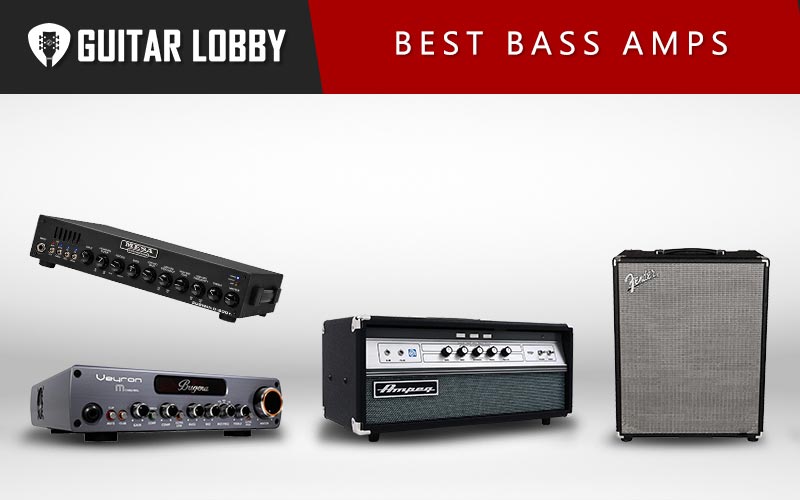
How many watts? Combo or stack? Tube or solid state? What kind of solid state? These questions are all fine and dandy to argue about at your local guitar shop, but here, we will walk through exactly what they mean and how to select the best bass amp for you. After you understand what you’re looking for, we’ll go over some of the best options on the market from a range of different styles and price points. Our team at Guitar Lobby has tested and owned dozens of bass amps, and in this article, we’ll only be showing the highest quality amps at each price point.
| Name of Product | Image of Product | Description | Price Range | Full Review |
|---|---|---|---|---|
| 1. Ampeg SVT-VR (Best Tube Amp) | 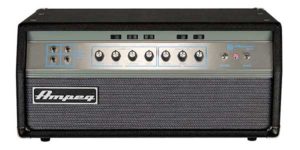 | Tube preamp and power amp with 300W RMS output at 2 or 4 ohms | $2,999 | Read Full Review Below |
| 2. Aguilar Tone Hammer 500 (Best Solid State Amp) | 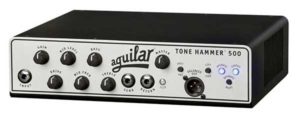 | Solid State, Class D with 500W RMS output at 4 ohms 250-300W RMS output at 8 ohms | $900 | Read Full Review Below |
| 3. Fender Rumble 500 v3 (Best Combo Amp) | 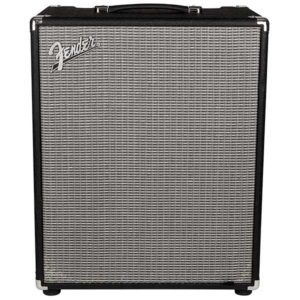 | Solid State, Class D with 2x10" speakers and 500W RMS output | $650 | Read Full Review Below |
| 4. Bugera Veyron BV1001M (Best Under $500) | 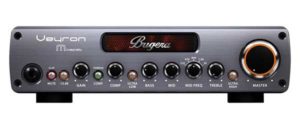 | Solid State, Class D with 600W RMS at 4 ohms and 350-400W RMS at 8 ohms | $500 | Read Full Review Below |
| 5. TC Electronic BQ500 (Best Under $300) | 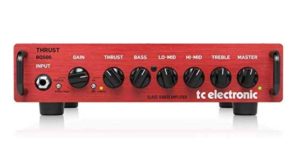 | Solid State, Class D with 500W RMS at 4 ohms and 300W RMS at 8 ohms | $280 | Read Full Review Below |
| 6. Ampeg BA-210v2 (Combo) | 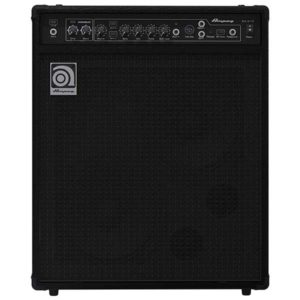 | Solid State with 2x10" speakers and 450W RMS | $660 | Read Full Review Below |
| 7. Fender Super Bassman Pro (Tube) | 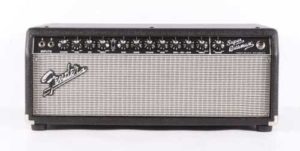 | Tube preamp and power amp with 300W RMS output at 2 ohms | $2,200 | Read Full Review Below |
| 8. Peavey MAX 250 (Combo) | 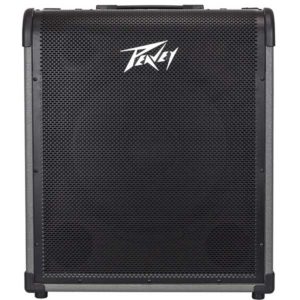 | Solid State with 1x15" speaker and 250W RMS output | $480 | Read Full Review Below |
| 9. Ampeg V-4B (Tube) | 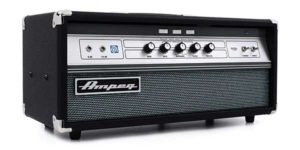 | Tube preamp and power amp and 100W RMS output | $1,500 | Read Full Review Below |
| 10. Mesa Subway D-800+ (Solid State) | 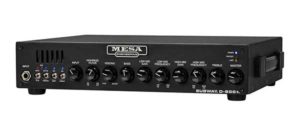 | Solid State, Class D with 800W RMS output | $1050 | Read Full Review Below |
| 11. Markbass Mini CMD 121P (Combo) | 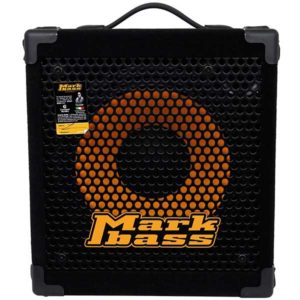 | Solid State with 1x12" speaker 300W RMS | $950 | Read Full Review Below |
| 12. Orange Terror Bass (Hybrid) | 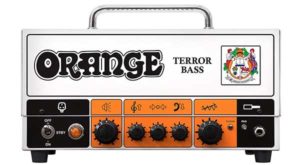 | Tube preamp and Solid State power amp with 250W RMS output at 8 ohms 500W RMS output at 4 ohms | $850 | Read Full Review Below |
| 13. Ampeg PF-800 (Solid State) | 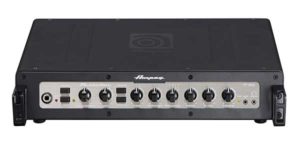 | Solid State, Class D with 800W RMS output at 4 ohms | $700 | Read Full Review Below |
| 14. Hartke HD150 (Combo) | 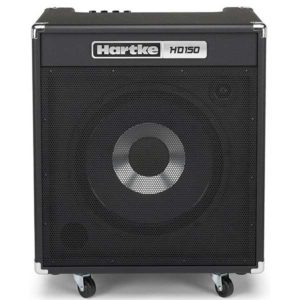 | Solid State 1x15" speaker with 150W RMS output | $400 | Read Full Review Below |
| 15. Ampeg PF-50T (Tube) | 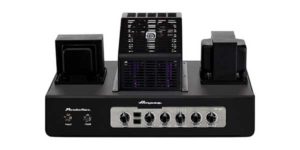 | Tube preamp and power amp 50W RMS output at 4 and 8 ohms | $1000 | Read Full Review Below |
| 16. Hartke TX 300 (Solid State) | 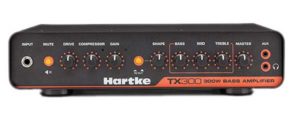 | Solid State, Class D 300W RMS output at 4 and 8 ohms | $360 | Read Full Review Below |
| 17. Orange Crush Bass 50 (Combo) | 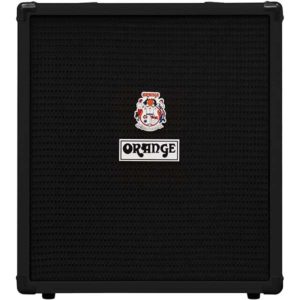 | Solid State with 1x12" speaker and 50W RMS output | $330 | Read Full Review Below |
Here Are Best Bass Amps Currently On the Market
1. Ampeg SVT (Best Tube Amp)
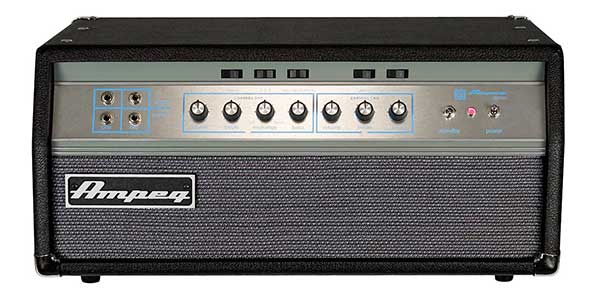
| Estimated Price | $2999 |
| Type | Tube |
| Power | 300W |
| Channels | 2 channel preamp |
My Review: Ampeg’s SVT line of all-tube amplifiers has been a staple of rock music ever since its birth in 1969. They’ve been used in countless albums, from classic rock of the early 70’s, to 90’s punk and grunge, and they are still relevant today. The warm distortion an SVT produces when it’s overdriven is so natural and instantly recognizable, that it will put a smile on any bassist’s face. The Ampeg SVT-VR is a reissue of the early 70’s SVT Blue-Line, and it seamlessly blends the legendary SVT sound with modern technology and features. Being in our number one spot as the best tube amp on the list, you have to expect the price tag on this amp to be a big one. However, if you’re willing to make the investment, you absolutely can’t go wrong with this tone. There are other options for anyone looking for an Ampeg tube sound at a lower price later on in the list, but if you need the creme of the crop, this is it.
Specs: This amp boasts 300 watts RMS at 2Ω and 4Ω. Being powered by six output tubes makes this amp loud enough for any size venue you could play. The SVT-VR is two feet wide, almost a foot tall, and just over a foot deep. It’s also quite heavy, weighing in at 85 pounds. There are two separate channels, each with bright and normal options, giving you a total of four different inputs to choose from. These inputs can even be patched together to mix the two channels. Channel one has a three band eq with rocker switches above each knob that allows you to boost the treble and bass or cut the bass, and choose between three different ranges of mids to cut or boost. Channel 2 has treble and bass controls that can both be boosted. The SVT-VR has two ¼” speaker outputs and one speakon output. It also has a balanced direct line out with a pre/post eq switch, which determines whether the output signal is raw or controlled by the eq on the amp.
Target Customer: The SVT-VR is for someone who is serious about classic tone and needs a lot of power for their gigs. The price is certainly high and is probably far too much for any casual player to even consider, but if you’re planning to play big stages and you can’t compromise on a big sound that has been used in many of your favorite classic albums and world tours, this might be a good investment for you.
Bottom Line: This is the best of the best. For those who need that classic sound at a high volume, it may be worth it. Luckily for new bass players (or even the professionals that just aren’t playing concert halls), there are cheaper options for good tube tone. If you’re more interested in an amp that can give you loud cleans as well as grit, this next option could be for you.
2. Aguilar Tone Hammer 500 (Best Solid State Amp)
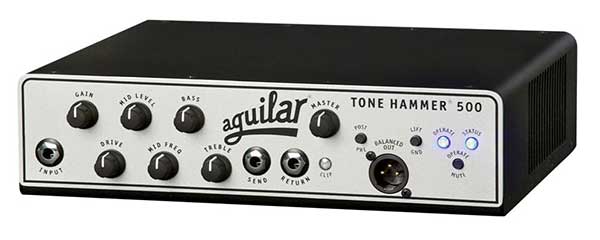
| Estimated Price | $900 |
| Type | Solid State |
| Power | 500W at 4 ohms, 250W at 8 ohms |
| Channels | Single channel |
My Review: Aguilar is becoming a modern standard in bass amplification, especially with its solid state products. Its use by artists of extreme technicality (such as John Patitucci and Thundercat) is a testament to its precise and accurate sound. The Tone Hammer 500 is one of Aguilar’s most popular amps, and for good reason. The clean tone of this amp is as transparent as it gets. This is perfect if you want the sound of your fingers on the string to go straight to the listener’s ears exactly as you play it. If you need a little color, though (or even a lot), the Tone Hammer has a drive control to add in harmonic distortion to give it an overdriven sound.
Specs: As the name states, this amp can output 500 watts at 4Ω, but at 8Ω it’s reduced to around 250-300 watts. Being a Class D amplifier makes the Tone Hammer incredibly small. It takes up an area of less than a square foot, and only weighs four pounds. The controls include a gain, master volume, drive, and a three band eq. Included in the eq is a mid frequency selector knob that allows you to choose which mid frequency you want to cut or boost. A -10db switch is provided at the input for active basses. The front face also has an effects loop, a balanced output with a post/pre eq switch, and a mute button. The back has a tuner output, and two speakon speaker outs.
Target Customer: Just because this amp is under half the price of the last entry doesn’t mean it’s any less professional. The Hammer Tone 500 is perfect for serious musicians who want a good tone that doesn’t have to be identical to classic rockers (though it can get close). You can certainly crank the drive if you need to, but the tone hammer is best used to accurately represent the clean tone of your bass, and allow you to shape it through eq. Also the portability is something that any gigging musician can get behind!
Bottom Line: Clean tone is the name of the game with Aguilar. If you need a little less or more power than the TH 500, they also have a 300 and 700-watt version. Though $750 seems cheap compared to a $2,200 SVT, it’s still a hefty price tag for the bassist on a budget. Luckily, if this is the case for you, there are other options for clean solid state amps that are cheaper without too many sacrifices to tone or versatility.
3. Fender Rumble 500 v3 (Best Combo Amp)
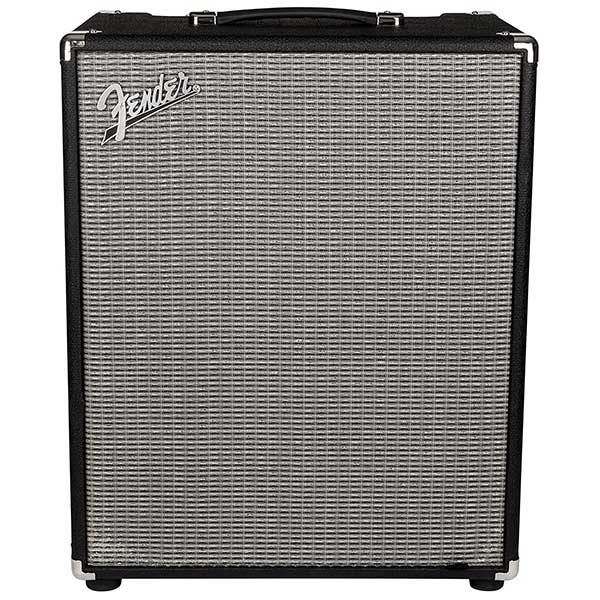
| Estimated Price | $650 |
| Type | Solid State, Class D |
| Power | 500W |
| Channels | 2 channel |
My Review: It was a close call for the best combo spot on the list, but ultimately, the Fender Rumble 500 gives the most bang for your buck, and it’s a staple in bass amplification. Though it is a Class D solid state, the Rumble is an incredibly classic sounding amp, even at its cleanest setting. This means it’s not as tight and true as other modern solid state amps, but it provides a wonderful traditional tone in a powerful combo.
Specs: The Rumble 500 produces 500-watts, as the name suggests, and has two 10” speakers and a switchable compression horn (basically an active tweeter) for high frequencies. The Rumble line also consists of a few lower watt combos, if you don’t want something as powerful. The overdrive channel is switchable via a button on the control face, or a footswitch, it has a drive knob that controls the amount of distortion, and there is a level knob that controls its blend with the clean channel. There are three different tone shaping switches, Bright, Contour, and Vintage. There is also a four band eq and a gain and mast volume control. The outputs include a direct out (fixed to post eq), an effects loop, and a ¼” speaker out that can drive an 8Ω cab at 250 watts. There is also an ⅛” aux and headphones input on the back. It’s about 2’ tall and has a footprint of around 1½’ squared. The weight of this combo is a surprising 35 pounds.
Target Customer: This amp is for someone who wants a range of professional classic tones in a portable and affordable manner. If you’re in need of something tighter and more modern-sounding, the Rumble 500 might not be for you, but since it’s incredibly lightweight and affordable for a professional amp, it’s perfect for anyone looking for a traditional sound in a gigging combo.
Bottom Line: The Rumble 500 is very much an all-in-one amplifier in terms of classic tone, and it is quite portable at such a lightweight. This is exactly what we are looking for in a combo and the amount of power it provides for the price makes it one of the best combos of the market.
4. Bugera Veyron BV1001M (Best Under $500)
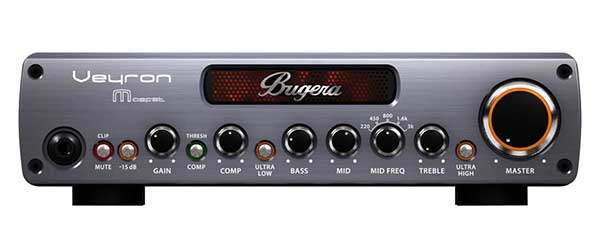
| Estimated Price | $500 |
| Type | Solid State, Class D |
| Power | 2,000W at 4 ohms |
| Channels | Single channel |
My Review: The Bugera Veyron BV1001M is a great modern sounding Class D amp head for the $400-500 price range. It’s similar to the Tone Hammer in its clean and tight tone, but there is no built-in overdrive, so harmonic coloration is at a minimum from this amp. An aspect that makes it particularly well suited to modern styles, especially slap, is the onboard compressor, which can help control your dynamics and produce a smoother sound.
Specs: The wattage advertised for the BV1001M is 2,000 at 4Ω, but don’t get too excited, because this is a peak rating. Nevertheless, it’s RMS output is around 600 watts at 4Ω and 350-400 at 8Ω, which is still a lot of power for such a small footprint and a solid price. It’s a bit smaller than a square foot in area, 4” tall, and weighs 8 pounds. The input has a mute and -15db switch, and there are both gain and master volume controls. As I mentioned before, it has a switchable onboard compressor with a light to indicate when your level hits the threshold. There is also a footswitch input on the back to enable the compressor. The eq has three bands, a midrange frequency selector knob, and high and low-end boost switches. The back has two speakon outputs (4Ω minimum), an effects loop, a tuner output, ¼” headphone and aux inputs, and a direct output. The line out has a ground switch, post/pre eq switch, and a switch that lets you change the signal from mic to line level.
Target Customer: The BV1001M is for anyone seeking a tight modern sound for a good price, at the sacrifice of an overdrive channel. The onboard compressor and clean tone make it well suited for slap bass in particular.
Bottom Line: Besides being a lot of bang for your buck, there is also a sense of style with this amplifier that isn’t present in a lot of small Class D amps. If you’re in the market good modern looks as well as good modern tone, and you want it for under $500, this is easily one of the best bass amps.
5. TC Electronic BQ500 (Best Under $300)
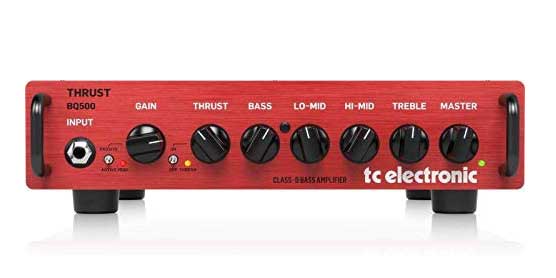
| Estimated Price | $280 |
| Type | Solid State, Class D |
| Power | 500W |
| Channels | Single channel |
My Review: If you’re a musician on a budget like I am, and the Tone Hammer and BV1001M sounded perfect for you, but maybe a bit too expensive, then this is the next best option at a price that is tough to beat. TC Electronics have been known for making spectacular gear that is much more affordable than other products of similar quality. The BQ500 is no exception. Though it has a few fewer bells and whistles than the other Class D amps on this list, it gets the job done at an excellent price. I should know because this is the amp I personally use to gig and rehearse!
Specs: The BQ500 puts out 500 watts at 4Ω and around 300 watts at 8Ω, which puts it on par with many other professional solid state amps in terms of power. It has a footprint of less than 10” squared and weighs 5 pounds, making this one of the most portable amps on the list. The input has a pad for active basses as well as a peak indicator. A knob labeled “thrust” controls an onboard compressor that has an off/on switch and a threshold light. Finally, there is a 4 band eq and a gain and master volume control. Though there is no effects loop , this amp still has an aux and headphone input (both ⅛”), a direct out with a pre/post eq switch, and a speakon speaker output.
Target Customer: As I said before, if you liked the sound of the Tone Hammer or the BV1001M, but not the price, the BQ500 is a good budget option. Though it has no overdrive option and a few fewer inputs, it still has an onboard compressor and a tight modern tone, making it great for slap bass in particular.
Bottom Line: For the musician on a budget, the BQ500 provides an amazing clean tone at a power suitable for medium to large venues and rehearsal spaces. If you don’t mind sacrificing an effects loop and overdrive channel, this amp is an excellent piece of gear for an awesome price.
6. Ampeg BA-210v2
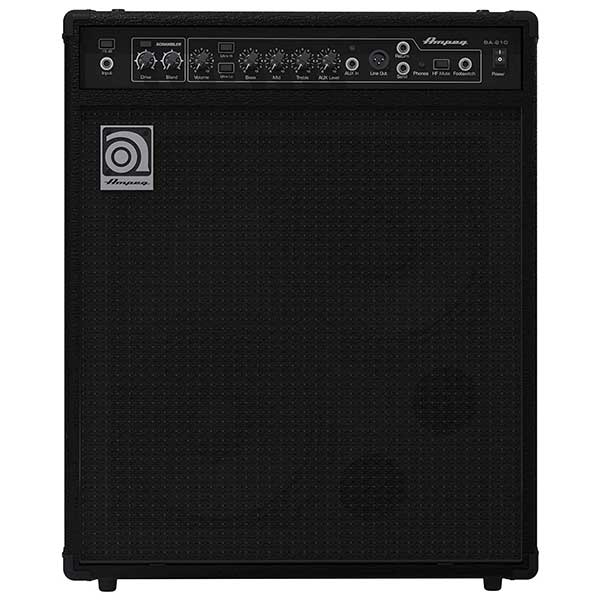
| Estimated Price | $660 |
| Type | Solid State, Class D |
| Power | 450W |
| Channels | Single channel |
My Review: Ampeg sneaks in again with the BA-210v2. This amp is one of the most versatile combos on the market for a price that’s hard to beat. There are many similarities between this combo, and the Fender Rumble series combos, so if you are looking for a similar amp at a lower price, this is one to consider. The tone is one that consumers have come to expect from ampeg products: wonderful. Being a solid state amp means it can stay clean at loud volumes, but it also has drive control that is reminiscent of the classic SVT tube sound.
Specs: Two 10” speakers and 450 watts means this combo can really get the job done in terms of volume. It also has a 1” high frequency tweeter for those who need a little extra treble in their tone and a switch that can turn it off if you need less high-end. The input has a -15db switch for active basses and is immediately followed by a “scrambler” that allows you to switch on or off the drive controls. There are two of those, by the way; a drive knob that allows you to adjust the level of overdrive, and a blend knob that allows you to choose how much of it is mixed with your clean signal. Both of these can also be switched on and off via a footswitch input at the other end of the control face. There are two eq switches that boost high and low frequencies and a traditional three band eq. The BA-210 also has a ¼” and ⅛” aux input, and a knob to adjust the aux level. While there is a direct out, it doesn’t have a pre eq switch. A slanted cabinet shape that allows you to use your amp as a stage monitor if you’re going through a PA system, which is quite a unique feature among combo amps. An effects loop and an ⅛” headphone input are also included. Weighing around 55 pounds makes it heavier than the Rumble 500, but it’s still manageable.
Target Customer: If a stack is out of the question, but you still want a gigging amp that will hold up in different venues and rehearsal spaces, this is a good amp for you.
Bottom Line: The BA-210 is cheaper than the Rumble 500, but it doesn’t have quite as much power or any speaker outputs. However, it can give you a duality of clean and overdriven tone at your fingertips in a sizable and reliable combo that won’t break your back.
7. Fender Super Bassman Pro
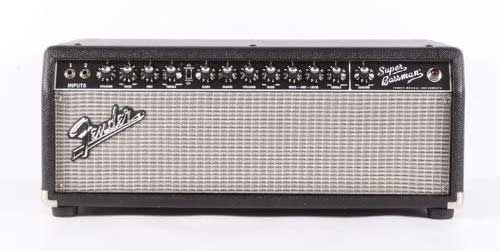
| Estimated Price | $2,200 |
| Type | Tube |
| Power | 300W |
| Channels | 2 channel |
My Review: Now we are getting back to the classics with another all tube amplifier. Though not as popular as the SVT, the Super Bassman is still a staple in rock bass tone. The Bassman also has a more open airy tone. This gives it less of the “in-your-face” quality that Ampeg is famous for, but it makes for a very nice clean tone and more gentle overdrive which is great for classic rock.
Specs: Like the SVT, the Super Bassman can push 300w at a 2Ω minimum, and is loud enough to fill a stadium. It has two inputs and two switchable channels, Vintage and Overdrive. The vintage channel has a volume and three band eq, but the treble and bass knobs are both pullable in order to boost them. The overdrive channel has a gain control and a blend knob that allows you to mix your clean signal with the overdrive. There is a three band eq here as well, with the treble and bass pull pots, but a mid frequency selector is also included on this channel. The overall master volume is a pull pot as well that can mute the amp. The back of the amp has two ¼” speaker outputs with an impedance selector, a footswitch to change channels, a tuner out, and an effects loop. The direct out has a pre/post switch, as well as its own level control.
Target Customer: Like the SVT, this amp is a big investment. It’s best suited to large venues and a classic overdriven sound. If you’re serious about tube tone and you need it loud, the Super Bassman Pro is another good option for you.
Bottom Line: Though not punchy as the SVT, the Bassman is still a classic sounding amp fit for the largest stage you could dream of playing. However, you may be someone who wants an all tube amp, but doesn’t plan on playing any stadiums or concert halls in the future. Don’t worry if that’s the case, because there are plenty of tube amps that are less powerful (and less pricey) on the market.
8. Peavey MAX 250
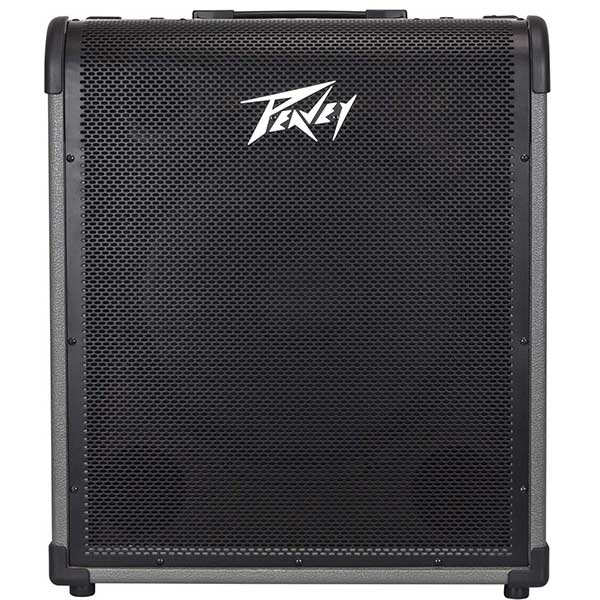
| Estimated Price | $480 |
| Type | Solid State |
| Power | 250W |
| Channels | Single Channel |
My Review: Like TC Electronics, Peavey is popular for its high quality, affordable gear. The MAX amplifier line is a perfect example of this. Though the MAX 250 is only 250 watts, as the name suggests, there are a lot of intriguing features that make it well worth the price. Something unique to this amplifier is the tilted speaker, which is angled upward so it can be easily heard when on the ground. Also, the MAX 250 sports a 15” speaker which is quite difficult to find in an amp of this power and price range.
Specs: At 250 watts, this amp is less powerful than earlier combos on the list, but it is the first in its price range to house a 15” speaker. It also has a switchable tweeter. The control face has active and passive inputs, a gain control with an overdrive switch, a volume knob with a harmonic boost switch (to give the illusion of more low end), and a chromatic tuner. There is a three band eq with a bass roll-off switch, a mid range selector switch, and a bright switch under each control respectively. The back has an effects loop, a direct out (no pre/post switch), headphone and aux inputs, and a foot switch for the overdrive. There is one speakon output that can drive an 8Ω cab at 300 watts, which definitely helps to alleviate concerns about its power. At about 45 pounds, it falls halfway between the Rumble and the BA-210 in terms of weight, and it’s only a few inches shorter and wider than those to accommodate the larger speaker.
Target Customer: If you don’t need quite as much power to keep up with your band, or if you want something extra loud for home or recording use, this amp will do the trick. In my opinion, this is also a great gigging amp for someone who plans on adding another cabinet. With another 15” or two 10” speakers, this baby could really sing, and you still have the simplicity of a combo if you are playing at home or you’re playing a light gig.
Bottom Line: There are a lot of similarities between the MAX 250 and the BA-210 and Rumble amplifiers. This is certainly the odd one out, but its unique features keep it in the running as one of the best, high-watt (or semi-high-watt) combos on the list.
9. Ampeg V-4B
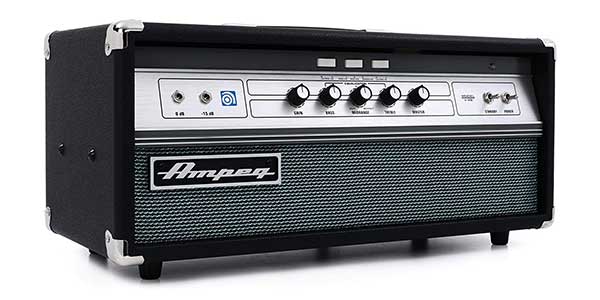
| Estimated Price | $1,500 |
| Type | Tube |
| Power | 100W |
| Channels | Single channel |
My Review: Here is our first all tube head under 300 watts. Though it’s not a stadium rocker like the SVT or Super Bassman, it still packs plenty of power at 100 watts. Ampeg tube tone still isn’t cheap in this case, but it’s certainly less of an investment than an SVT, and it’s perfect for large concert venues. The tone is remarkably similar to an SVT with a great overdriven tube sound.
Specs: The controls are rather simple on this amp. There is a passive and -15db active input, a volume and gain control, and a three band eq. Like the SVT, the V-4B eq does have three rocker switches to boost lows and highs and to select the midrange. The back has an effects loop, a slave output, and a direct out (no pre/post switch). The speaker outs are all ¼”, and there are five of them. That’s right, five. Two outs at 2Ω, two at 4Ω, and one at 8Ω. This makes the amount of possible cabinet combinations huge.
Target Customer: The V-4B is also a reissue of a 70’s ampeg head, so there is no denying that it has the classic tube driven tone that we look (or rather, listen) for in rock. If you need that sound in a gigging amp, but not at volumes that can shake a city block, the V-4B is a great choice. This amp is also well suited to anyone who wants to have a lot of options in terms of cabinets, given the amount of speaker outputs it provides.
Bottom Line: Ampeg tone is not sacrificed by any means in this amplifier. Just because it’s not as loud as an SVT, doesn’t mean the V-4B can’t pack a punch with a beautiful overdriven sound that can make angels and audiophiles alike weep with joy.
10 Mesa Subway D-800+
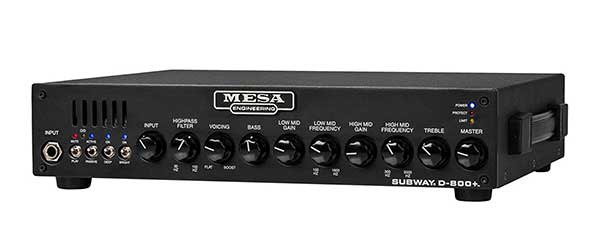
| Estimated Price | $1050 |
| Type | Solid State |
| Power | 800W at 4 ohms |
| Channels | Single channel |
My Review: This solid state amp head is a true powerhouse in terms of wattage and tone. Mesa has always been focused on bass amps as a company, and it shows in the tight, modern tone of the Subway D-800+. This line of amps also includes the D-800 for a lower price and a simpler control layout and the more expensive hybrid WD-800 that has a tube driven preamp. The D-800+ makes the list here because of its extensive eq controls which allow you to shape your tone much more precisely than most other amplifiers.
Specs: As you could guess by the name, the D-800+ can put out 800 watts RMS, which makes it one of the most powerful solid states on this list. The input has a mute and passive/active switch and there is an input volume (gain) and a master volume. There is a four band eq with frequency range selector knobs for both the low and high mids, and there are switches to boost the bass and treble. If that’s not enough tone control for you, this amp also has a highpass filter to cut low end, and a voice knob to boost harmonics and add more presence to your tone. The direct output on the back has a mic/line level and a pre/post eq switch. There is also an effects loop, tuner output, ¼” headphone and aux inputs, and a footswitch input for the mute. There are two speaker outputs that can switch between 2Ω and 4Ω. It’s a bit larger than other Class D amps on the list, but it only weighs in at 6½ pounds.
Target Customer: Mesa’s tone is unmistakable and is very popular for funk and fusion bass playing styles (especially slap). If you have a worry that you won’t get quite enough power from the 500-watt heads listed above, this amp will easily take it off your mind. It is suited for large venues, and can even keep up with some of the tube amps on the list!
Bottom Line: Though this is one of the more expensive solid state amps on the list, it’s for good reason. The limitless options in tone shaping and the amount of power provided in such a portable head makes the D-800+ one of the best high-watt solid state amps on the market today.
11. Markbass Mini CMD 121P
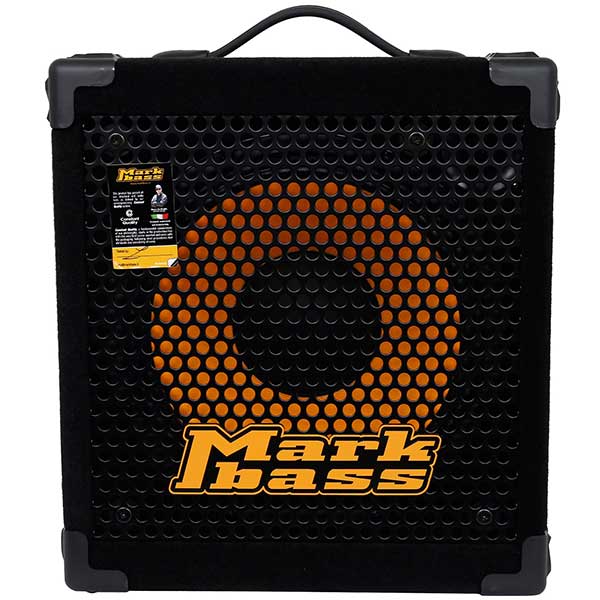
| Estimated Price | $950 |
| Type | Solid State |
| Power | 500W at 4 ohm, 300W at 8 ohm |
| Channels | Single channel |
My Review: With the word “bass” in the company name, it shouldn’t come as a surprise that Markbass is dedicated to great bass tone. Though they haven’t made the list much since classics like Ampeg and Fender have taken a lot of the higher places, Markbass produces gear of phenomenal quality. Their combos specifically are what they are most known for, but their high price is what has kept them off the list thus far. Nevertheless, the Mini CMD 121P is a spectacular sounding amp with an incredibly tight punch that is a result of Markbass speakers and cabinet design, just as much as their amplifiers.
Specs: The Mini CMD 121P is a 300 watt combo with a 12” speaker. However, it does have a speakon speaker output that can allow it to produce 500 watts by adding an 8Ω cabinet. Along with the ¼” input, there is also a balanced XLR input for mic cables. The controls consist of a gain, volume, four band eq, and two filter knobs. The first of these is the VLE (vintage loudspeaker emulator) which is a shelf eq that cuts high frequencies to give the amp a more traditional sound. The other filter is the VPF (variable preshaped filter) is a midrange scoop that helps to accentuate your lows and highs. There is also a level control for the direct out on the control face. The back has an effects loop, tuner output, and a direct out with a pre/post eq switch. The whole thing is just under 30 pounds which makes it an incredibly portable combo.
Target Customer: This particular combo is very much a “tone over power” situation (or “tone over budget” maybe). However, if you are into tight modern tone for slap or funk bass, you don’t need a ton of power, and the price isn’t an issue, the Mini CMD 121P will treat you well.
Bottom Line: Though it is a low wattage, do keep in mind that this amp can reach 500 watts with another cabinet, making it a two in one rig that can suit large gigs just as well as your living room. The price is certainly high, but you’re paying for quality from the amp, to the speaker, and all the way down to the cabinet material and design. As a brand, Markbass sets high expectations, and they meet them with the Mini CMD 121P.
12. Orange Terror Bass
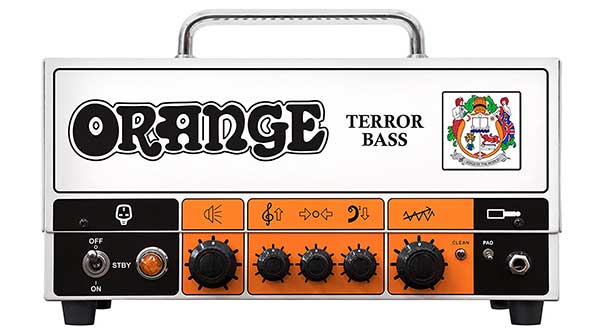
| Estimated Price | $850 |
| Type | Hybrid |
| Power | 500W |
| Channels | Single channel |
My Review: The Orange Terror Bass is a hybrid amp, which means it has a tube preamp, but a Class D power amplifier. This helps to give it an overdriven tube sound while keeping it lightweight and in a lower price range. Orange is known for a very heavy overdriven tone which makes it great for hard rock and metal. The Terror and it’s guitar counterpart, the Micro Terror, were made to appease fans of the original Tiny Terror head that gained a lot of popularity as a low-watt hybrid amplifier. While the Terror carries on the tone and the portability, it packs a full 500 watts which makes it plenty powerful for large venues.
Specs: With 250 watts at 8Ω and 500 watts at 4Ω, the Terror can move a lot of air considering it only weighs 10¼ pounds. This is even more impressive when you consider it’s tube driven preamp. The control layout is very simple with only a gain, volume, and three band eq. There is also a pad for active basses and a channel switch for clean or overdriven sounds. There are two speakon outputs on the back and a direct out and effects loop on the side.
Target Customer: Metal heads only! Just kidding, but be prepared for a hard rock sound if you get this amp. This is a great option for someone who wants a bit of tube driven sound without paying for a full tube amp. Keep in mind though, other amps on this list like the SVT and the BV1001M offer hybrid versions, which might be worth checking out if you don’t want something so heavy (in sound, not weight) as the Terror.
Bottom Line:
Orange amplifiers in general are definitely for heavy music. Metal and hard rock are very well suited to the roaring lows and crunchy distortion of the Terror. The tube preamp also gives it a little bit of the color of a classic tube amp, without breaking you back or the bank.
13. Ampeg PF-800
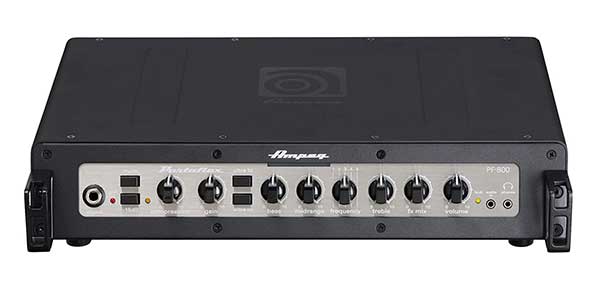
| Estimated Price | $700 |
| Type | Solid State |
| Power | 800W at 4 ohms |
| Channels | Single Channel |
My Review: If a high-watt solid state amp is appealing to you but you need a more classic tone or the Mesa D-800+ is just too expensive, the Ampeg PF-800 is another great and more affordable option for a powerful solid state head. Though there are plenty of different wattage options in Ampeg’s Portaflex line, the PF-800 takes this spot for providing a ton of power and a great classic tone in a portable Class D amp for a good price.
Specs: Starting at the input, the PF-800 has a mute and -15db switch as well as a peak indicator. 800 watts at 4Ω is impressive enough on its own, but an onboard compressor with a threshold indicator is also included to add even more presence and volume to your sound. Following the compressor is a gain control and a three band eq. The eq has low and high-end boost switches and a midrange selector knob. Finally, the control face includes a mix knob that controls the level of the effects loop, a master volume, and ⅛” aux and headphone inputs. The back has both ¼” and speakon outputs, and a direct out with a pre/post eq switch and a -40db pad to reduce it to mic level. A footswitch, effects loop, and tuner output are also included. It is large for a Class D amp, measuring about 15” wide and 11” deep. It also weighs a bit more, at 12 pounds, but being able to produce 800 watts should easily excuse it.
Target Customer: Similar to the Tone Hammer in its ability to produce both modern cleans and classic overdrive makes this amp great for anyone who needs a portable Swiss Army knife. 800 watts is great for large venues or rehearsal spaces that call for a ton of volume.
Bottom Line: An onboard compressor, great tone shaping options, and 800 watts in a portable and affordable head gives the PF-800 amazing value in the realm of high-watt solid state amps. The sheer amount of Ampeg amps on this list is a testament to their beloved tone, which the Portaflex line encapsulates well. So well in fact, that there is another amp from this line further on the list, but you’ll be surprised by how different it is.
14. Hartke HD150
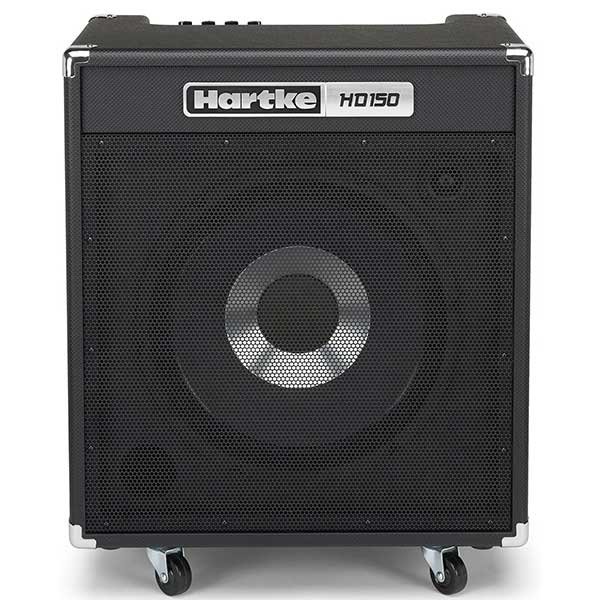
| Estimated Price | $400 |
| Type | Solid State |
| Power | 150W |
| Channels | Single Channel |
My Review: Now we are starting to get into the realm of low-watt bass amps that are better for home and recording use. The Hartke HD150 is a great amp for situations that don’t call for a lot of power. One of the great things about this particular combo is that even though the wattage is relatively low, it still has a 15” speaker, which will help boost the volume, and provide a deeper low end. Hartke is popular for their modern tone and their great eq controls. Many virtuosic jazz bassists are fond of their products, including Victor Wooten who is endorsed by them.
Specs: This is a 150-watt amp which places it on the lower end of the spectrum, but it can still hold up in low volume gigging situations since it has a 15” speaker. It also has a 1” tweeter, though it’s not switchable. The controls don’t offer any overdrive, but there is a seven band eq with a bass, mid, and treble knob, and five sliders to notch specific frequencies. There is also an aux and headphone input, a direct out (no pre/post switch), and an effects loop all on the control face. The HD150 is rather heavy, weighing 66 pounds, but to accommodate for this, it comes with attachable wheels.
Target Customer: This amp is best for home use, but it can even work in low volume situations or venues that can accommodate the direct out. However, with no speaker output, your volume options will be limited. The HD150 is well suited to players who want a lot of control over their eq. While the seven bands are great for precise tone shaping, it may confuse less experienced players, so if you are new to the bass, you’d probably favor a simple layout.
Bottom Line: In my opinion, given its weight and low wattage, this amp is great for occupying a space in your living area or bedroom as a go-to amp for at home jam sessions or practice. 150 watts gives you plenty of power for home use, plus a little extra in the event that you do need to use it for a gig.
15. Ampeg PF-50T
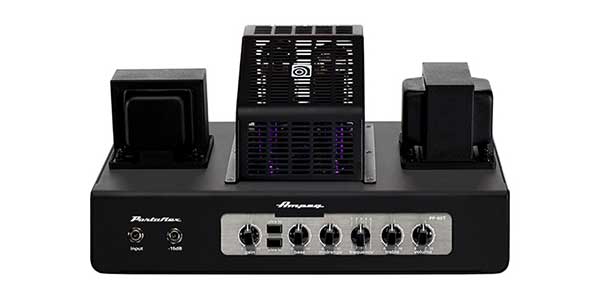
| Estimated Price | $1,000 |
| Type | Tube |
| Power | 50W |
| Channels | Single Channel |
My Review: Finally we’ve gotten to a tube amp for the home bodies. Though I already reviewed an amp from the Portaflex line, the applications for the PF-50T are incredibly different and it takes this place for being the most widely used low-watt tube amp on the market. With 50 watts of tube power, this little amp still has a fair amount of power, but it’s best for home use and, more specifically, recording situations. The PF-50T is a no load amp which means it doesn’t need to be played through a cabinet at all times like most other amps which is great for bassists who want an amp solely for recording. This allows you to get great tube tone by plugging straight into an interface without worrying about a speaker cabinet. It is still a high priced piece of gear, especially for one that is mostly utilized for home and recording use. Nevertheless, it has a true tube driven sound, so if that’s what you need in a low-watt format, you can’t go wrong with the PF-50T.
Specs: This amp keeps the 50 watts up at both 4Ω and 8Ω, so there’s no loss of power with a higher ohm load. It also has an incredibly small footprint, measuring a bit over a foot wide, 7” tall, and 10” deep. This makes it a great desktop amp for Home recording studios. Weighing in at just under 20 pounds means it’s also incredibly portable compared to other tube amps. On the control face, there is a passive and an active -15db input, a gain and volume control, and a three band eq. The eq also has low and high-end boost switches and a midrange frequency selector, which you can probably tell by now is pretty common for Ampeg amplifiers. The back has a ¼” speaker out with a 4Ω or 8Ω selector switch, a direct out with a post/pre eq, and a transformer line out which is great for recording because it carries the exact same signal as the speaker output, making it even more true to the amplifier.
Target Customer: This amp is definitely an investment, but in a different way than the 300-watt tube heads. While those amps are an investment in tone and power, the PF-50t is for those who are willing to invest in tube tone but need a low volume for home or recording settings.
Bottom Line: Ampeg is on this list multiple times for a reason, and the reason is that they always deliver in every price range and every style. Even in their smallest amp head line, Portaflex, they provide an all tube option that sounds spectacular at a lower price and wattage.
16. Hartke TX 300
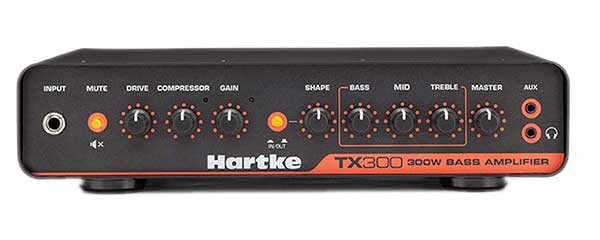
| Estimated Price | $360 |
| Type | Solid State |
| Power | 300W |
| Channels | Single channel |
My Review: The TX300 is a great budget gigging amp that doesn’t have a ton of power, but includes a good selection of onboard effects. As I mentioned before, Hartke is popular among jazz bassists for having a clean sound and great eq controls, but this head leans a little more into the mainstream by trading extended eq shaping for a built in overdrive and compressor.
Specs: The input has a mute switch and is followed by the drive, compressor, and gain controls. There is a threshold indicator light by the compressor and a peak light by the gain. A three band eq is accompanied by a “shape” knob which is basically a mid range selector that can be switched on or off and changes frequency as the knob is adjusted. At the end of the control, face is a master volume and ⅛” aux and headphone inputs. The back has an effects loop, direct out (no pre/post), and ¼” and speakon speaker outputs that both operate at 4Ω and 8Ω. The TX300 measures a little over a foot wide and 10” deep and it weighs only 5 pounds which makes it just as portable as the other Class D amps on the list.
Target Customer: TX 300 will do well in small or medium sized gigs and is a good midway for someone who wants a lot of onboard effects on a budget. Due to these effects and it’s a simple layout, this is an amp I’d recommend for a new bassist or someone who is planning to upgrade from a practice amp.
Bottom Line: While not the best Class D amplifier on the market, it does contain a lot of desirable features. The Hartke TX300 is small, lightweight, and versatile, which is what we look for in solid state budget amps.
17. Orange Crush Bass 50
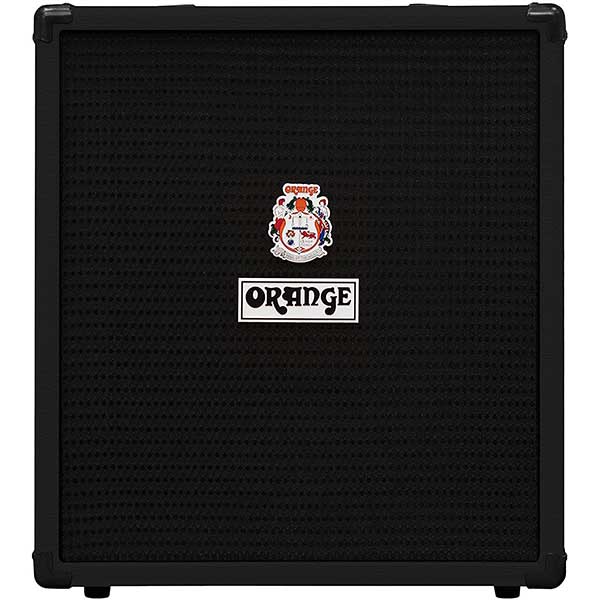
| Estimated Price | $330 |
| Type | Solid State |
| Power | 50W |
| Channels | Single Channel |
My Review: With some great Orange tone that isn’t quite as heavy and crunchy as the Terror, the Crush Bass 50 is a wonderful option for a small and affordable practice amp that doesn’t sacrifice sound quality. You may have noticed that I shy away from combo amps with single 10” speakers. While they are great in pairs, I recommend trying to go for a 12” or 15” speaker in a practice amp to make sure you can get a full low end despite the minimal wattage. Sadly very few low-watt amps have a speaker this large. That’s why I placed this Crush, with a 12” speaker, on the list as an amazing practice amp. Do keep in mind though, that many of the combos on this list are part of a line with different sizes, so you can also check out their smaller watt versions if you’re in the market for a practice amp.
Specs: This amp is also packed full of great little features that make it very well suited for practice. It has an effects loop (which is wonderful for an amp this size) and an onboard tuner. The effects loop also has a blend knob to mix it with your clean signal. The input has a pad for active basses and there is also an ⅛” aux input and a ¼” headphone jack. The rest of the controls consist of a gain, volume, and three band eg with a midrange selector switch. This combo is only 32 pounds which isn’t too surprising since it’s only 1½’ high. Altogether these features make for a great practice amp.
Target Customer: You can probably guess by now, that this is not a gigging amp. However, you can tell that Orange designed this amp with practice specifically in mind, and that puts it leagues ahead of other low watt amps that try to split the difference between practice and gigging (and usually miss the mark). I would recommend this amp to beginners and professionals alike for its great tone, features, and portability (which makes it a wonderful little travel amp as well, by the way).
Bottom Line: This is one of the best options on the market for a high quality practice amp. An onboard tuner, effects loop, headphone, aux jacks, and three band eq are all great features, but the 12” speaker alongside all of them really sells it. I’m so impressed by this little amp, I may even pick one up myself.
Choosing the Right Bass Amp (Buying Guide)
This section is for those of you who want to learn more about bass amps before reading reviews.
Wattage Considerations
The first thing to consider is what kind of wattage you want. There are many different factors that contribute to an amp’s overall volume (speaker size, effects, tube or solid state, etc.). However, wattage is one of the most prominent specs that is advertised, and this will narrow down your search based on what kind of power you want your new amp to have.
Amps are usually given two ratings of wattage: RMS and Peak. RMS (root mean square) is basically the maximum average wattage that an amp can be safely played continuously. Since it’s good to give your signal some headroom, or space to grow in volume (i.e. not cranking the volume and gain up to 11), the actual power that an amp puts out will likely sit below the RMS rating. That being said, RMS is a reliable way to discern the power of an amp in comparison to others. Peak wattage, for our intents and purposes, is basically a marketing scheme. Though it is possible and useful to know in other applications, driving an amp at its peak wattage will cause it to fail quickly. It may be included in advertising to make an amplifier seem more powerful. By now, consumers have mostly picked up on this, so peak ratings aren’t advertised as prominently as they used to be. If there is only one unspecified wattage rating, it is usually safe to assume that it‘s RMS.
If you are only planning to practice alone in your house, 20 to 50 watts is plenty (unless you’re trying to piss off the neighbors). However, in a band setting, holding your place in a mix with a drum kit and guitars often requires significantly more power. While human hearing can extend down to 20 Hz in theory, we tend to perceive mid-range frequencies (~250-5,000 Hz) as much louder than low-end frequencies. Sadly for us bass players, this is a majority of a guitar’s range. The bass has a frequency range of around 40-400 Hz (closer to the 40 Hz end in typical basslines), near the lower limit of our hearing. This means that a bass needs a lot more volume than a guitar to be perceived at the same level. Though effects like eq, compression, and distortion play a large role in this dynamic discrepancy, starting off with a more powerful amp will give you a leg up in matching your guitarist’s volume. It’s a common practice to take the wattage of your guitarist’s amp and double it to get an estimate of what wattage your bass amp should be. In the spirit of “better safe than sorry,” I recommend multiplying it by 2.5. This means that if your guitarist is pushing 100 watts, you’d do well to match them with a 250-watt amp. If you are planning to use compression or distortion, your guitarist plays clean for the most part, or you’re getting a tube amp, using the rule of 2 could work well enough. However, adding an extra 50% to your wattage is a way to ensure that there will be enough headroom for your amp to happily pump a clean signal that can be heard in the mix.
BUT, there is a loophole that may greatly influence the wattage of your desired amplifier. It’s a thin line to walk, but it could save you from trying to match your guitarist’s (God forbid) 240-watt Marshall half-stack. This loophole is the magical direct output.
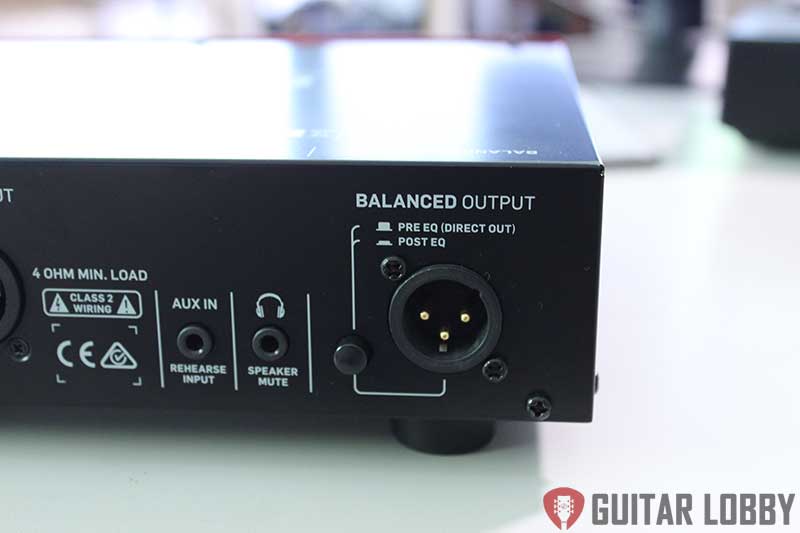
A direct out is an output that allows a line (usually XLR) to carry your signal directly from your amp to the mixing console of a PA. If a venue has a decent PA (i.e. with subwoofers) and a good sound guy, a 50-watt bass amp with a direct out can match a guitar amp that is loud enough to fill the venue without a mic. That’s a big “if,” though. Sadly, for many smaller or DIY venues, such accommodations are quite difficult to come by, which makes this a dicey option. It could be a perfect setup for you if you want a small amp for home use, and you occasionally play at a venue with a sophisticated sound system, like a church. If you’re like me, and some of the venues you play lack the capabilities to boost your volume this way, or if you won’t be able to convince your guitarist to turn down a bit during rehearsal, the 2.5:1 bass to guitar ratio is the way to go.
From personal experience, I can say that I certainly wish I used that ratio for my rigs’s wattage while I was in the market for one. My guitarist has a 150-watt amp, while my stack pushes about 300 watts, which gives me the popular ratio of 2:1. Though I can still keep up with the band, I have to sacrifice a lot of headroom to do so. Luckily, there are three things that saved me from my mistake. The first of these was the direct output. Even with a high-watt amp, a direct out can make a world of difference if a venue can accommodate it. The second was an onboard compressor. This could easily be replaced with a compressor pedal, but since I didn’t own one at the time, it saved me some money as well as headroom. The final saving grace of the amp I chose (don’t worry, we’ll review it in detail later on), was the capability to expand it in the future. Since I decided to go with a stack, by simply adding another 8 ohm cab or replacing mine with a 4 ohm cab, my currently 300-watt setup could push 500 watts easily. But wait; what’s an ohm (Ω)? How do you shop for a cabinet? Don’t fret (pun intended; sorry). I’ll explain these things after we compare stacks and combos, and decide which will best fit your needs.
Combo vs. Stack
So which should you get: a combo amp, or a head and a cabinet? This is a discussion best organized into pros and cons. Since combos are the simpler of the two options, they’re up first.
Being simple is a major draw for combo amplifiers. Since the amp is paired with a speaker (or speakers) in the factory, you don’t have to worry about the impedance or wattage handling of a speaker cabinet. You can plug it in and play through it right out of the box and it’ll work and sound fine. For some, this reduced complication is welcome, but if you’re the kind of person that likes to have a lot of options, it may be limiting. There is a solution, though. If you want a combo, and the ability to add and swap cabinets, there are combo amps that provide a speaker output to accommodate this.
The transportation of a combo amp is also simple; as simple as it gets, really. Once you grab your amp and power cord, you’ve got it all. Moving a stack means keeping track of a head, power cable, speaker cables, and however many cabs you decide to pair it with. While this is a lot to move, each part will inevitably be lighter than a high watt combo. If you’re in the market for a small, low watt amp, the weight of a combo won’t be an issue, and its simplicity may win you over. If you need more power, though, and you don’t want to break your back hulking a 500-watt combo up the steps of a DIY venue, then a stack might be more appealing.
Right off the bat, stacks are typically more expensive, which we can all agree is a solid con. Though amp heads and cabinets may be cheaper on their own, their combined price will most likely be more than a combo of the same power and quality. The con of a stack forcing you to shop for yet another piece of gear after you choose your amp may actually be looked at as a pro by some, though. Shopping for a cab does require some extra knowledge on impedance, but we’ll go over everything you need to know about it if you decide to take up the challenge. Being able to pick your speakers can open up a window of sonic variety that isn’t offered by combos. Aside from the variety of speakers, you can also change the amount of speakers in your setup to increase your volume if needed. As I mentioned earlier, if my guitarist ever decides to upgrade his amp, all I need is to add a speaker cabinet to bump my stack up to 500 watts. However, keep in mind, this is also possible with a combo that has a speaker output, should you have your heart set on one.
Another upside to a stack’s mix and match versatility is the ability to share a cabinet with others while using your own head. This might not apply to you if you don’t play gigs with other bands, but if you do, then you are probably familiar with the common practice of sharing equipment between bands. It cuts down on the amount of gear each band needs to bring, and it saves time between sets. But you’d much rather use your own gear. I mean, who wouldn’t? Owning a stack can enable multiple bassists to bring their amp heads and share a single cab (or set of cabs). Everyone is familiar with the amps they are playing through, and only one bassist has to bring their whole stack. It’s a win-win.
Choosing Speakers
Don’t skip this section if you’ve settled on a combo! Though you won’t have the option to mix and match heads with cabinets, the size, amount, and type of speakers offered by different combos should be weighed in your final decision. I’ll go over these factors first, before diving into impedance and choosing a speaker cab in the next section.
Bass combos and cabinets contain speakers that are specifically designed to handle low frequencies. These are commonly confused for subwoofers, but they are actually quite different. Bass speakers are more versatile and have a larger harmonic range, while subwoofers have a narrow range, with a heavy emphasis on low-end frequencies (~20-200 Hz). This is because subwoofers are meant to be used in conjunction with mid-range and high-end speakers, while bass amp speakers need to cover the entire range of the bass guitar on their own. Some bass amps/cabs also have a smaller speaker called a tweeter. This is a speaker designed to reproduce high-end frequencies. The idea of including a tweeter is to ensure that the high harmonics of the bass can be reproduced. Most bass speaker cabs don’t have a tweeter, but they are rather common in large combos these days. Though they do brighten up your tone, it isn’t an incredibly significant difference, since bass speakers already reproduce a fair amount of harmonics. In the context of a band, some people say that a tweeter will help your sound cut through. Truly, I tell you, extending your harmonic range up to 20 kHz (which anyone over the age of 20 is hard pressed to hear, anyway) won’t be noticeable on stage. Besides, it’s called a bass guitar for a reason. Tweeters certainly don’t hurt anything, and they can brighten up your sound, but it’s my firm opinion that they shouldn’t weigh too heavily on your decision.
Of course, speakers come in different sizes and amounts. The important thing to keep in mind in regards to volume is that larger speakers will move more air. The more air a speaker pushes, the louder it sounds. Higher volume can be achieved by adding speakers, but it’s not as effective as a larger speaker diameter. Two 10” speakers will have a similar volume to one 12” (or maybe 15”) speaker, even though their combined diameter is larger. There are tonal differences between speaker sizes as well. 8” and 10” speakers tend to be tight and punchy, while 12” and 15” speakers are more open and boost the bass frequencies better. All of these differences can be changed and adjusted by eq and other effects, but it’s good to start out with a sound that’s closest to your end goal. If you’re shopping for a low-watt combo amp, you probably won’t have any choices above a single 10” speaker. However, larger amps and cabs offer a variety of different speaker sizes and amounts, and some even have combinations of different speaker sizes (not including tweeters).
Choosing a Cabinet
Before we dig into this, I must say two things. Firstly, if you’ve decided you’re in the market for a combo and you don’t plan on adding any speaker cabinets to it, this information isn’t necessary for your shopping. Secondly, please don’t hang on to any delusions that you can get away with pairing a new bass amp head with a guitar cab you already own. While it is possible (if you’re careful), it shouldn’t be considered as a serious option. Your tone would suffer greatly, and if you had to crank the volume, the speakers probably wouldn’t hold out. Purchasing a cab specified for bass is a necessity if you are serious about producing a good sound. Luckily, choosing a bass cabinet isn’t too difficult once you know the differences between speaker sizes (which you do!) and you have an amp picked out.
The two things that you need to be mindful of when shopping for a cabinet are impedance and wattage handling. Impedance (measured in ohms, Ω) is the amount of resistance that the speakers give the power of the amp. Amps have a minimum ohm load (generally 4Ω or 8Ω) that they can handle, and this is the resistance at which they will push the most wattage (unless they specify that they can produce the same wattage over multiple ohm loads, but this is rare for instrument amplifiers).
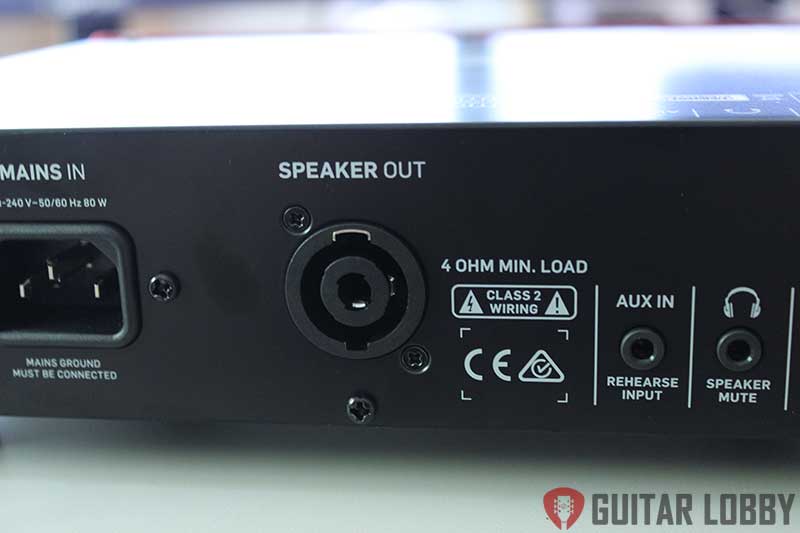
Matching this minimum load with your cabinet will work well, but since the amp will be running near its maximum capacity, you need to be careful not to overdo it. You can use speakers with a higher ohm load to be certain that your amp will drive them comfortably without a fear of pushing it too hard, but it won’t produce as much power.
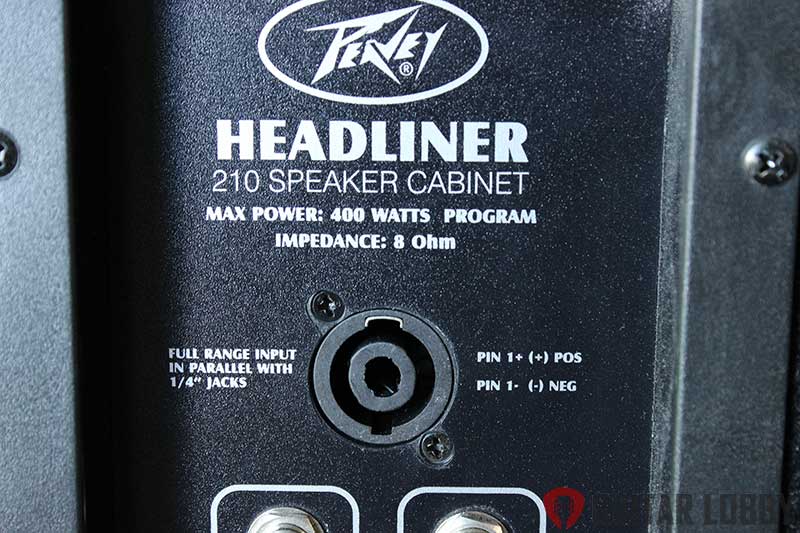
A cab with a resistance lower than your amp’s minimum ohm load is off the table, because it would likely cause your amp to fail.
The wattage an amp produces at different ohm loads may be advertised, but sometimes, this isn’t the case. If you were dealing with an ideal amplifier (i.e. an imaginary amp in a perfect world), the wattage would decrease by the same factor as the ohm load increases. I’ll use my own amplifier as an example. It is rated 500 watts RMS at 4Ω. Since it’s driving an 8Ω speaker cab, if my amp were ideal, it would produce 250 watts. You may remember though, that my amp actually pushes about 300 watts. Since there are no ideal amplifiers, and the world is far from perfect, wattage actually decreases at a lower rate than the increase of resistance. This rate is different between amplifiers, so if you want an exact value, checking the specs or contacting the manufacturer is necessary. However, reducing the wattage of your amp by about ⅔-⅗ as the ohm load doubles will give you a rough estimate.
Adding speaker cabinets changes the overall ohm load on the amp. The total resistance of a rig is equal to each cab’s load divided by the number of cabs. This is why I mentioned earlier that my amplifier would be able to push 500 watts if I added an 8Ω cab. Two 8Ω cabs would have a total resistance of 4Ω, which is the minimum load my amp is rated for.
The rule of thumb for wattage handling is pretty simple. Get a cab that can take more wattage than your amp will put out. This is a good way to ensure that your speakers will be safe, even while your amp is at high volumes. For two cabinets, expect each one to see a bit more than half of the amp’s RMS wattage.
Tube vs. Solid State
Thankfully, this debate is not nearly as heated for bass as it is for guitar amps. Some guitarists may call it a sacrilege to consider solid state amps as a serious alternative to a tube amp (which is an outdated view, to me, but that’s for another article). Bass players, on the other hand, tend to be much more open to solid state amplifiers, many even preferring them.
To start, tube amps are louder. I mentioned before that you can probably stick to the 2:1 bass to guitar amp ratio if you plan on buying one. The main sonic draws for tube amps are their warmth and the way that they distort at high volumes. Aside from sounding pleasant and natural, the breakup that occurs when you push a tube amp is gradual and can help accent the dynamics of your playing. Digital distortion from solid state amps will manifest as clipping, which sounds quite harsh. The color that a tube amp gives your tone is what you’d hear on almost any classic rock album before the 80’s. This might be perfect for you if you’re the nostalgic type. Conversely, if you are looking for a clean tone without any coloration from the amplifier, then a solid state is the way to go.
Though watt for watt, tube amps are louder, the level of wattage provided by solid states on the market is significantly higher, especially when considering their small size and lightweight. That size for amp heads, by the way, can be small enough to fit in a backpack for many modern Class D amplifiers. Yeah, I mean small. This makes solid state more portable than tube amps, which is great when you also have a bass and a cabinet (or two) to carry. Reliability is another point for solid state amps. For all their sonic wonders, tubes are high maintenance, don’t last forever, and can fail spontaneously for a number of reasons, stranding you without an amp right before a gig. Although that last one’s not a common worry for tube amps (unless you dropped it a few times on your way to the venue), there’s virtually no chance that a solid state amp won’t work as expected when you plug it in.
Types of Solid State
There are four types of solid state amplifiers that are defined by class (only two are standard for bass amps, though). Different classes provide a different balance of efficiency and linearity (or how faithfully your signal is reproduced when it’s amplified). Each of these aspects comes at the compromise of the other, so there are a variety of different advantages and drawbacks in each class.
Both Class A and Class B amps are incredibly unbalanced between their efficiency and linearity which results in their frequent use as modern instrument amplifiers. Class A has some exceptions as guitar amplifiers, but you won’t see many as bass amps on the market. Class A amps directly amplify the entire signal faithfully, but they are horribly inefficient and produce a lot of heat. Class B amplifiers achieve a higher efficiency by splitting the signal in half between two amplifiers. However, when the signal is combined, a gap is left where it was split resulting in distortion.
Class AB is the first viable option for a bass amp. Similarly to Class B, AB amps split the signal between two amplifiers. However, in this case, each amplifier handles slightly more than half of the signal. This allows some overlap when the signal is combined, excluding any gap distortion. Class AB amps are large, though, and tend to be rather expensive.
A smaller, cheaper option, is the Class D amplifier. Class D amps have an incredible efficiency since they change the analog signal into pulse code modulation (digital) for the amplification process, which requires much less power. Because of this, their linearity is somewhat lacking. Technology is always improving though, and these days, Class D amps are starting to rival Class AB in sound quality. Though I already mentioned this, it bears repeating: Class D amplifiers are crazy portable. Many are small enough to fit in your backpack!
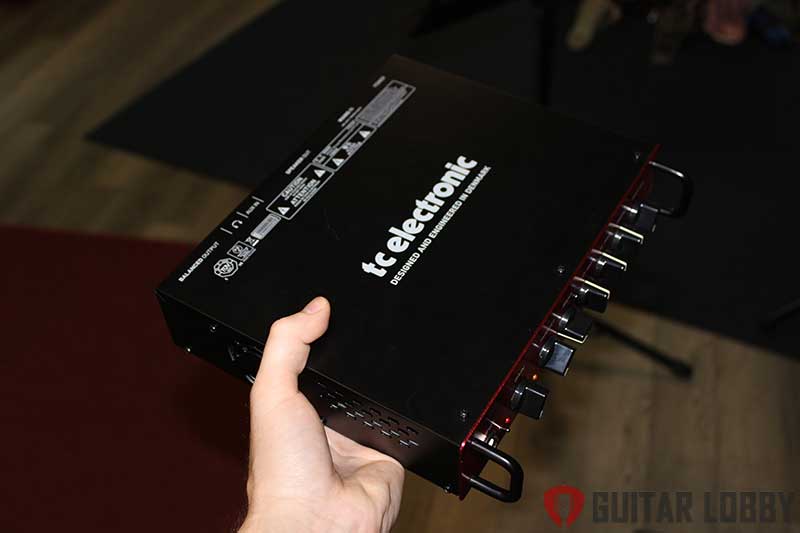
If easy transport is a must for you, Class D is the best option.

